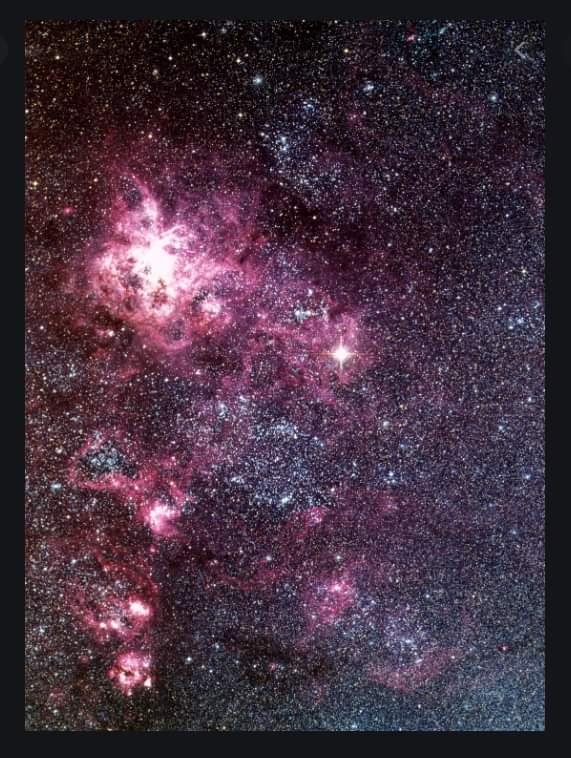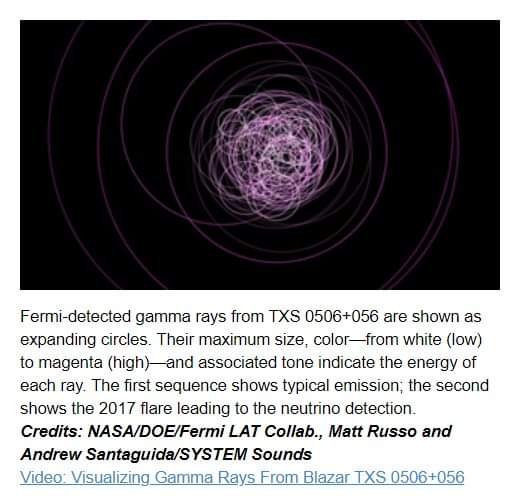Neutrinos - Colourification for Subatomic Identification and Analysis
An area of interstellar space proposes that neutrinos might be represented using the fastest colour, purple.
It seems fitting that the nearly massless particles would be among the fastest in the universe and therefore might be well represented by the purple wavelength. An interaction or decay need to be modeled using the purple colourization to confirm the fitting or not.
I found another citation to support the purple colourification of neutrinos. The photo expresses the inter-stellar phenomenon as purple.
NASA "Fermi-detected gamma rays from TXS 0506+056 are shown as expanding circles. Their maximum size, color—from white (low) to magenta (high)—and associated tone indicate the energy of each ray. The first sequence shows typical emission; the second shows the 2017 flare leading to the neutrino detection."
I am seeing evidence that there may not be any binding interactions between the particles I colour red and blue. This provides a clearer explanation as to why one would have to connect the two ends of the colour spectrum to perform the operation (red + blue) / 2 ..that is an invalid operation given the mathematics which express the colourwheel's relationship to a system of values correlated with the primary and secondary colours.
This means that purple might retain it's effective assignment to a single particle though it is a secondary colour. Secondary colours of lower order than purple have so far dependably represented the state of more than one primary coloured particle, as with red and yellow (orange) nuclei.
Excellent, I now have both ends of the spectrum and I know that the two ends do not join in nature nor mathematically.
So far we have red up quarks, orange nucleons and nuclei, yellow down quarks, blue electrons and now a single particle secondary colour, purple neutrinos.
Leptons are suitably represented by the highest order colours (blue, purple) due to their low mass (charge/mass). ...............charge/mass, another piece.
Without this materializing charge/mass relation, I had no justification for why the heavier down quark (yellow) should be assigned a higher order in the chromatographic scale than the red up quark of lesser mass.
The charge/mass relation will assist in the colourification of the other particles in the standard model with relation to their energies, masses and binding interactions. Collisions might also be coloured adequately.
The colourification of neutrinos (purple) suggests they are least likely to "team up" with others, the ascetic particles.
According to colourification, there should exist two orders within the colour frequency spectrum. Quarks (first order) and leptons (second order). Slow/fast, long/short, heavy/light and positive/negative.
Recording an interference (neutrino) is a complicated procedure? ..yet super-cooled super-conducting superposition of charges is very easily perturbed. Quantum computing is even held back by the fact it detects disturbances too well. There were certain components of transistorized circuitry that could be implemented in reverse to achieve alternative application. If it does not fit at first, try the reverse, inverse, opposite and better yet complimentary.
Strange, mapping particles to the colour spectrum yields greater values for less mass and more energy. Particles which can be related to Jupiter and Saturn are finding their place in the colour spectrum with values of one, two and three.
We might not be able to extract exact quantization at first. A ratio for particle types contained in a particular stellar formation might be elaborated by colour-factoring and analyses determining the intensities of colour frequencies with relation to the subatomic content of colour_space [x1] ....[R, O, Y], [G, B, P].
Subatomic interstellar chromo-dynamics to optional chromatography two-dimensional plotting for the nostaligic and analytical purposes. Three-dimensional colour analyses would be more "en vogue", not necessarily easier to intuit intensity/magnitude results from. There should be a choice of two and three-dimensional representations as they are used to intuit results from different types of algorithm for various analytical motivations.
Look at that, a simple six colour bar graph can help us intuit more categories of information concerning the subatomic properties of a greater formation in space. Were we to "zoom in", we would notice details that are not represented in the generalized data about a galaxy or other configurations. Yet we can better understand and express the exponentially large and intricate ..in colour, with correlation to matter and energy.


Congratulations @deanpiecka! You have completed the following achievement on the Steem blockchain and have been rewarded with new badge(s) :
You can view your badges on your Steem Board and compare to others on the Steem Ranking
If you no longer want to receive notifications, reply to this comment with the word
STOPDo not miss the last post from @steemitboard: